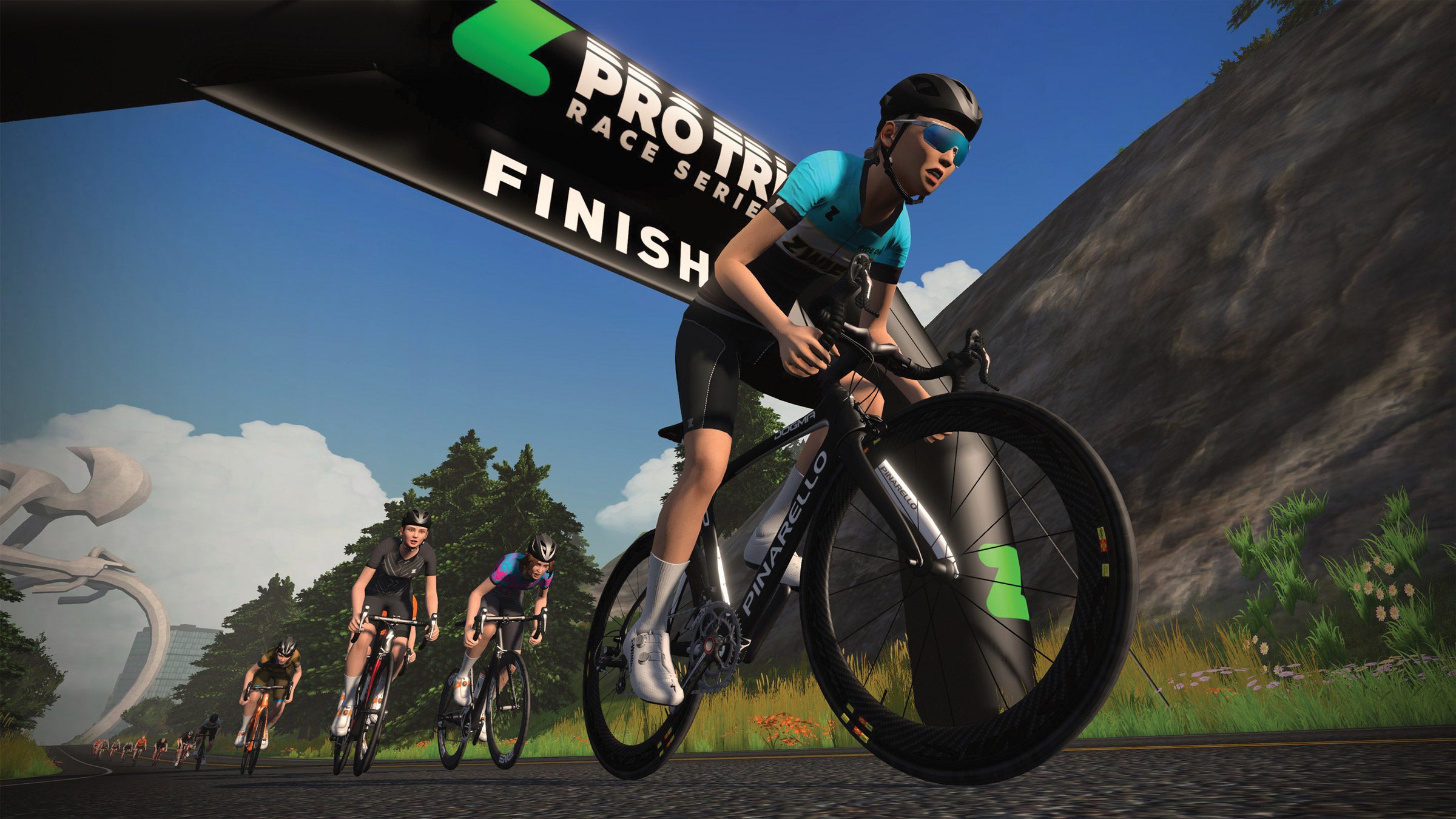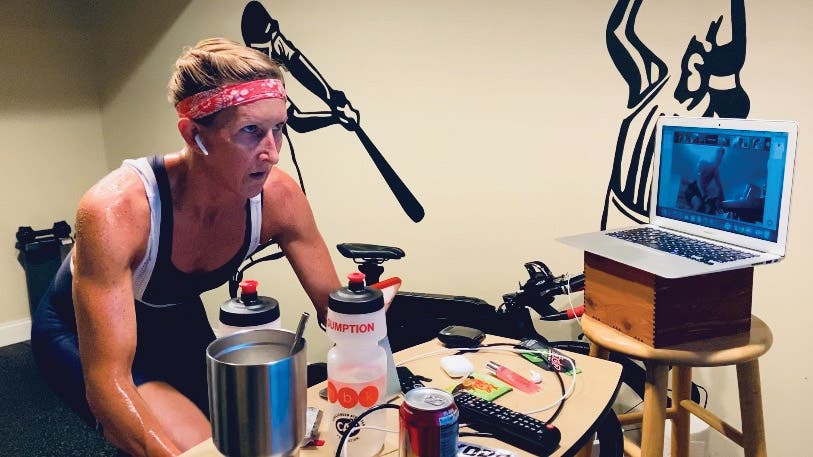How to Crush Virtual Racing

Athletes in action in the Zwift Pro Tri Race Series. (Photo: Zwift)
In the absence of the “real thing,” virtual racing, especially on virtual cycling platforms like Zwift, boomed in 2020—and that trend doesn’t look like it’s going to slow down any time soon. More than 130,000 athletes signed up for the Zwift Tri Academy program (a 50% increase from 2019) and close to 400,000 athletes from 180 nations registered to take part in at least one of the 34 Ironman VR events.
It seems triathletes all over the world are keen to still find a way to get their adrenaline pumping, even if there are very few in-person start lines. From DIY solo 5Ks to 70.3s using Rouvy and GPS watches to Zwift cycling races, the virtual landscape is full of options that provide exhilarating opportunities to go all-out without even leaving home. Virtual cycling races seem to have particularly captured athletes’ interest, most likely because (in addition to Zwift) there are so many different opportunities and platforms, such as TrainerRoad, Rouvy, and Sufferfest. Most of these online races are based on your power-to-weight ratio—how many watts you can put out for your weight in kilograms—and you can choose your race options based on categories (e.g., a category “A” race is between 4-6 w/kg). On a typical weekend, you can log on to Zwift, for instance, and choose any distance and intensity of race from a five-mile criterium to a 70-mile road race. And winning or placing happens in the exact same way it would in real life: You’ve got to ride the strongest, smartest race to cross the line first.
That said, to truly get the most out of it, keep in mind there are some key differences between racing IRL and in a virtual world. The differences span training, equipment, fueling, and learning the ins and outs of the virtual game platform itself. Once you’ve got all of these dialed, you and your avatar can take your virtual racing to the next level.
RELATED: Get Your Race On: Virtual Options for Triathletes

Training, Virtually
Virtual cycling races, like those on Zwift, often start all-out (be warmed up, already pedaling, and ready to go when the countdown comes)—and then they don’t slow down, with the fast and furious action condensed into 60 to 90 minutes. That means if you want to excel in Zwift races, then your training needs to replicate that effort. Jim Rutberg, co-author of Ride Inside, said: “They start extremely hard, stay hard in the middle, and finish hard. Just like outdoor racing, athletes and coaches have to look at the demands of the events—the power and time-at-intensity needed to achieve the desired performance—and train to those demands.”
Bike coach Matt Bottrill agreed. “If you’re going to be punching out short, sharp efforts, then you need to work on your variability in pacing with lots of intervals based around your extensive aerobic capacity,” he said. “It is also very important, especially for the shorter races, to ‘get out of the blocks’ well, so a good warm-up is key.” Keen Zwifter and pro triathlete Meredith Kessler takes some of her experience from real-life racing and applies it to the virtual Watopia world in Zwift, often doing recon of her virtual race courses well ahead of the event. “The best way to prepare for VR is to train, practice, and race on the courses you are going to have an actual VR race on,” she said. “You need to do your due diligence on the nooks and crannies of the courses and then do numerous virtual rides on them to experience their gradients and terrain for
yourself—yes, even virtually!”
In the virtual Zwift world, that means knowing where the steep climbs are because as soon as you hit those—much like in real life racing—you can expect the effort and intensity to skyrocket, so you need to be prepared for when that power surge is going to happen.
“VR is not just about how much power you can put out, it’s about knowing the course and the terrain, and how the VR works,” fellow pro Laura Siddall said. “For Zwift racing, you need to have ramped up to over your threshold power about 10-15 seconds before the race starts. If you aren’t going max when the gun goes you’ll be left behind. It’s also good to learn the intricacies of the course, any places where people may attack and also how the power-up feature works and when the best time to use these are to make the most of them.”
What is a power-up? It’s a feature unique to the video game-focused Zwift—kind of like picking up bonus powers and extra lives in Super Mario Brothers. There are different types of power-ups available on Zwift: The feather, for example, reduces your weight by 10% for 15 seconds, while the burrito turns off the draft effect for riders within a 2.5-meter radius of you for 10 seconds. (Yes, there is “drafting” in virtual racing too.)
Equip Yourself
As triathletes know only too well, your gear is an important part of your experience— especially when it comes to racing indoors. Your list of “must-haves” should include: a smart trainer, a rolling table on which to put your computer, a computer or tablet, a strong internet connection, a powerful fan, towels, trainer mat, plenty of fluid (and fuel, depending on ride duration), and music/ headphones.
Kessler prides herself on her “She Shed”—her indoor training pain cave that boasts all of the above. Her go-to smart trainer is the H3 Direct Drive Smart Trainer from Saris, while Rutberg and Bottrill swear by the Wahoo Kickr.
“That said, the level of quality and innovation throughout the indoor cycling market right now is so high that it’s hard for a consumer to go wrong,” Rutberg said.
The other thing that’s critical, he said: airflow and a good fan. “Heat is the enemy of endurance performance, and airflow directly influences the effectiveness of evaporative cooling. A puddle of sweat on the floor means you missed out on the greater cooling potential of evaporating that sweat off your skin,” he said—and that’s more of a challenge indoors, when there is no wind or natural airflow. It gets hot!
Plus, you need to have anything you might need within arm’s length, because there’s no catching back up if you have to get off the bike. Be prepared, have your fan set up, and your equipment ready to go.
Maintenance
Much like the real thing, virtual racing involves a lot of sweat. The difference is in an indoor environment it can really do some damage to your equipment if you don’t stay on top of cleaning and maintenance. “Sweat flies everywhere,” Kessler said. She recommends a sweat guard to keep it from reaching your frame. Bottrill said he always wipes down his bike after every workout and advises greasing all bolts regularly. Rutberg agreed. “Sweat happens and you have to be diligent about cleaning your equipment to prevent corrosion of vulnerable parts,” he said. “Unfortunately, there are plenty of examples of corroded handlebars and stem bolts, seized seat posts, and damaged frames, particularly if a person has a bike that has become a permanent fixture on the trainer.”
Fueling
Because most Zwift races are relatively short and typically high-intensity, calorie consumption (usually) takes second place to adequate hydration. Bottrill places a great deal of importance on electrolytes over anything else—and also advises getting your sweat rate checked.
“You will go through a lot more hydration in VR, because you are just sweating so much more, so it’s always good to have your table prepped with more bottles than you ever think you’ll need,” Siddall said. “With fueling, it depends on the length of the race, but because VR can be so much more intense you often need more of that instant energy. It also needs to be easily consumed, as you can’t really take your eye off the game.”
Even if you’re not Zwift racing, but doing a DIY time trial or longer solo virtual effort, it’s a good time to practice your fueling and hydration. Remember: There are no aid stations, so it’s all on you. “You are in a controlled environment where everything is right in front of you so there is no excuse for not practicing both your training and racing formulas,” Kessler said.
There are a myriad of ways to work virtual racing into your program, particularly in the winter and spring months when you’re looking for a higher intensity workout that might be tough to do outside. And with the right equipment and setup—as well as some targeted training—there’s a huge amount to be gained that’ll translate to the real world just as soon you’re back out there.
Virtual Races to Try
Zwift Races
Once you have a Zwift account, you can register for any available races, which can range in distance from short and fast criteriums to longer road races. It’s also worth getting the Zwift Companion app on your phone for easy access to events and interaction with other riders during the race.
Ironman VR
Sign up for a VR event or a virtual challenge using Ironman’s Virtual Club platform, complete the distance at home, and then see how you stack up against others in your age group. To be in the competitive category, you have to complete the run outside using a GPS watch and bike inside on the Rouvy platform using an approved smart trainer.
Virtual Challenges
There were an endless number of race organizers who turned their IRL events into online events this past year. You could run the Boston Marathon, London Marathon, Leadville 100, or complete a cycling elevation challenge on your own and then upload your results. Expect to see this trend continuing well into 2021.